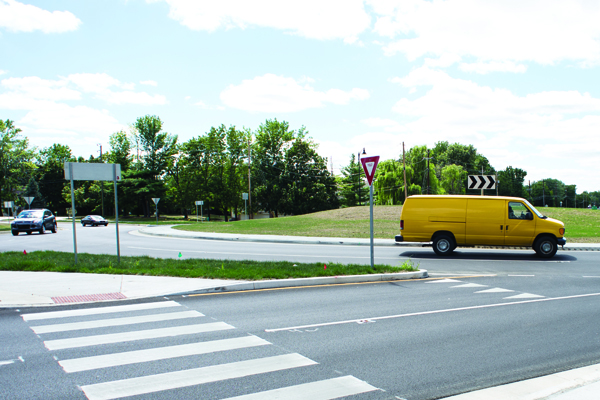
Three more roundabouts slated for construction this year; 28 proposed by 2018
By Karen Kennedy
Now that the roundabout at 96th Street and Towne Road is complete, the city has turned its focus to others in various stages of development. Three more are on the city’s proposed list for 2013. They are:
- Pennsylvania Street and 111th Street
- Illinois Street and 106th Street
- Illinois Street and Spring Mill Road
Carmel Drive and Range Line Road had until March of this year also been on the list for 2013 but now has been pushed back to next year.
How much does a roundabout cost and who pays for It?
There are several cost components to a roundabout.
- Engineering and design (typically 8 to 10 percent of the cost
- Right-of-way land cost (can vary greatly based on location and existing structures)
- Moving of utilities (which may be above or below ground)
- Construction and construction inspection
- The existing grade of the location can be a cost factor as well
When all of these various factors are considered, roundabouts can range in cost from $200,000 to several million dollars.
Roundabouts are funded in various ways. Depending on their location, they will be paid for through city funds combined with county, state or federal funds. Because of roundabouts’ positive impact on the environment, a federal program called CMAQ (Congestion, Mitigation, Air Quality) allows for 100 percent of the construction costs to be paid by the federal government, but the purchase of land for right-of-ways and engineering, landscaping and maintenance costs fall to local governments.
But because some portion of the cost of any new roundabout will ultimately come from the city’s budget, the city council must approve the funding, so they always will have the right of final refusal on any particular project.
Of the roundabouts on this year’s schedule, funding is planned as follows:
- Pennsylvania and 111th streets – receiving some federal funds
- Illinois and 106th streets – not yet funded as it will fall under the umbrella of the Illinois Street project
- Illinois Street and Spring Mill Road – 100-percent city funded
The city also has applied for a Transportation Investment Generating Economic Recovery (TIGER) grant to create a new, separated grade interchange at 96th Street and Keystone Parkway which would include roundabouts at the ramp entrances and exits. According to the Dept. of Transportation’s website, TIGER grants are awarded through the DOT for road improvement projects that will have “a significant impact on a metropolitan area or region, and make communities more livable and sustainable.” 96th Street and Keystone Parkway is the only Keystone Parkway interchange in Carmel that has not been converted to a roundabout.
Why do we need them?
Obviously, Mayor Jim Brainard is a huge proponent of roundabouts. The City of Carmel is widely known for having more roundabouts than any other city in the U.S. Currently, there are 78.
His reasons? Traffic flow, cost efficiency, safety, aesthetics and the environment, he said.
“Roundabouts handle four to five times the capacity of stoplights,” Brainard said. “A single stoplight costs $150,000 to install and uses electricity 24/7. In addition to being better for the environment, through less idling time and fuel consumption, roundabouts make for safer city streets. They eliminate left-hand turns, which create a huge potential for accidents. They reduce accidents in general by 40 percent and accident injuries by 80 percent.”
Varying opinions
“Roundabouts are not necessarily good for businesses,” Carmel City Councilor Luci Snyder said. “They are great people movers, and they keep traffic flowing. But businesses need people to stop. When someone is sitting at a stoplight, they look around. They notice the sign in a store window. Merchant’s Square is a good example of a place that has been hurt by roundabout construction. It’s harder to stop there. People who used to frequent that area simply found other places to go.”
“Also,” Snyder said, “as beneficial as Keystone Parkway is to moving traffic and increasing home values in the area, unless you are a local, it’s confusing to know exactly where to get off. People may drive right past the ramp they needed to use to get to Merchant’s Square.”
While Snyder believes that certain streets are prime candidates for roundabouts, she is opposed to adding any in the Range Line Road retail district.
Council member Ron Carter disagrees.
“The roundabouts on Keystone Parkway have increased business for those west of Keystone,” Carter said. “But we do need better signage for the exits to those businesses. Keystone used to be a barrier for residents living west of it.
“I was in the advertising business for most of my career. Retailers need to use the tools available to them to promote their goods and services. I hear what Councilor Snyder is saying about going slow past businesses, but look at it this way: if traffic is always bad at a particular (stoplight) intersection, people will come to avoid that area altogether.”
2014 and beyond
Twenty-eight more roundabouts are on the proposed list through the end of 2018, almost all of them two lanes, at an average of about seven per year. Because these projects are assigned, not bid, they have already been assigned to various area engineering firms through 2015.



